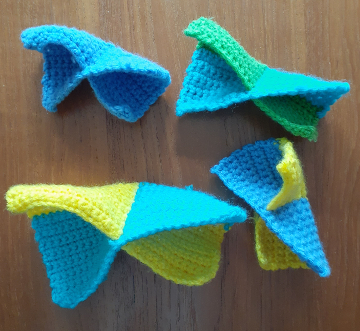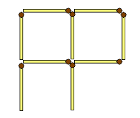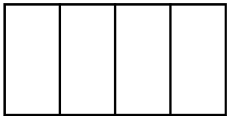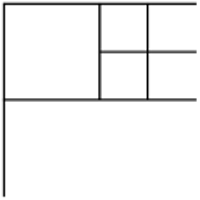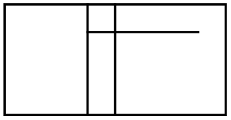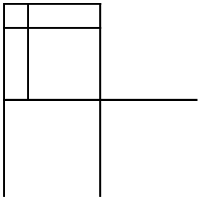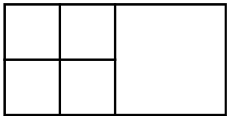Dividing Chores
Before dividing chores, let’s divide a cake. Suppose I bought a two-layer cake. One layer is chocolate and the other is vanilla. Suppose I love chocolate and hate vanilla, My friend, Joe, is the opposite: he loves vanilla and hates chocolate. It’s very easy to divide the cake. I take all the chocolate, and Joe takes all the vanilla. I think I am lucky to get the full value of the whole cake. Joe feels lucky too.
My point is that people with different tastes can divide things so that both get more than half by their own estimates.
Let’s look at another example. Suppose Alice and Bob are divorcing. Their estate consists of one valuable thing: a portrait of Alice’s grandfather. Alice loved her grandfather and values the portrait at 10,000 dollars. Meanwhile, Bob values it the same as its market value, 2,000 dollars. There exists a division algorithm, called the Knaster procedure, which allows them to divide the portrait so that both of them end up with the same amount of money on top of their perceived half of the estate.
I will skip the calculations. The end result is that Alice gets the portrait and pays Bob 3,000 dollars. In her view, she gets a portrait worth 10,000 and loses 3,000. Her total gain is 7,000 dollars, which is 2,000 more than her estimated half. Bob gets 3,000 dollars. In his view, half of the estate is 1,000 dollars, and he gets 2,000 more than that.
The bigger the difference in perceived value, the more each person gets in addition to their expected half. Suppose this difference is D. If you trust my calculations, the Knaster procedure means each person gets D/4, in addition to one half of their estate’s perceived value.
The same idea can be applied to chores. Suppose I hate shopping while my husband hates doing the dishes. So, I can do the dishes, and he can shop. And we can live happily ever after without doing the things we hate.
So, theoretically, it is very profitable for two people to live together. Have you seen couples where each one thinks that they won the lottery by marrying their partner? Such couples benefit from dividing chores, appreciate their partners’ help, and are happy.
I have seen such couples, though not many. Actually, not many at all. If mathematics says that living together should be profitable, then why are happy couples such a rarity?
I will divide unhappy couples into four categories depending on whether they both benefit from dividing the chores and whether they both appreciate each other.
Benefit and appreciate. In this case, other parameters could affect their happiness: love, sex, children, jobs, and so on. Consider, for example, Alice and Bob. Alice relies on her husband for financial support for her and their small children and appreciates said support. Bob likes how Alice cares for the children and appreciates her for that. However, Alice doesn’t love Bob anymore, and Bob wants something special in his sex life but is afraid to request it from Alice. They are both profoundly unhappy.
Benefit and do not appreciate. It is possible that both people do not appreciate each other, or it could be just one. In addition, it could be that a person underestimates the real value of the partner’s contribution, or it could be that the appreciation is not enough for the partner. This became a more complicated paragraph than I initially expected. As Lev Tolstoy said, “All happy families are alike; each unhappy family is unhappy in its own way.” So, let me have two subcases.
Benefit and do not appreciate. Case 1. Underestimation. Such couples have a good division of labor but underestimate each others’ contribution. For example, Bob thinks that staying at home with children is a walk in the park. He thinks his job is way more difficult than his wife’s daily caring for the house and the children. He assumes that when he returns from work, the house needs to be clean and dinner ready. He is very angry when this doesn’t happen. Alice is very unhappy as she knows how much she actually works.
Benefit and do not appreciate. Case 2. No gratitude. Such couples have a good division of labor but do not express their gratitude sufficiently for the other partner. For example, Alice wants Bob to take her out to dinner as a thank you. Or to say thank you on a regular basis. But Bob brags to his friends that he is lucky in marriage and thinks that this is enough. Everyone but her knows that he feels lucky.
Do not benefit. It is usually one person who is used. There are many ways for people to force their spouses to divide the chores in their favor. There are many types of abusive relationships. I do not even want to give an example. After all, my goal was to discuss the mathematics of chores’ division, not to analyze why people do not divide their labor fairly.
Special cases. Life is complicated. Here is the case that doesn’t quite fit the cases above as the division of chores with time delays. For example, Alice worked and cared for the children while Bob went to medical school. The benefit for Alice was implied in the future. Bob promised to shower her with money when he would get rich. However, as soon as he got rich, he showered someone else.
The mathematics show that living with a partner can be extremely beneficial for both. But people’s emotions are complicated. They do not follow mathematics and often mess it up in more ways than I can imagine.
Share:
